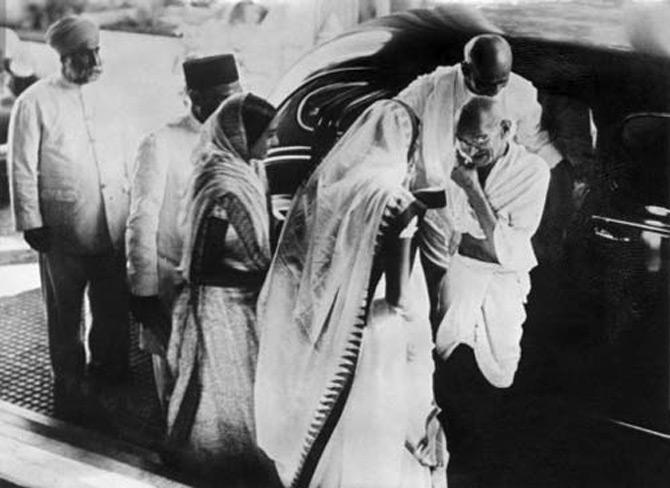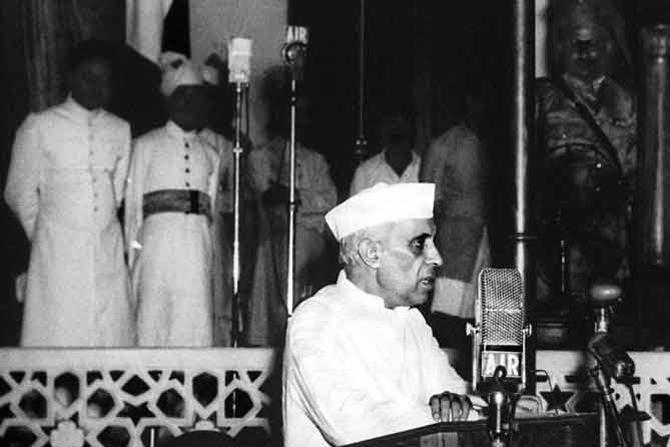The Quit India resolution was launched by Mahatma Gandhi at the Gowalia Tank Maidan also known as the August Kranti Maidan in Mumbai where the Congress parry passed the famous 'Quit India resolution' urging the British to leave India once and for all

Mahatma Gandhi sits with Jawaharlal Nehru, during the Congress Party meeting in Bombay (now Mumbai) at the Gowalia Tank also known as August Kranti Maidan on August 9, 1942
"There is a mantra that I give you. You imprint it on your heart and let every breath of yours give an expression to it. The mantra is Do or Die.", said Mahatma Gandhi in his ferocious speech at the launch of the Quit India Movement at the Gowalia Tank Maidan in Mumbai (then Bombay).
ADVERTISEMENT
Today is August 8, 2019. This day, 77 years ago on August 8, 1942, Mahatma Gandhi launched the civil disobedience movement, also known as the Quit India Movement at the Gowalia Tank Maidan in Mumbai. While giving the Quit India speech, Gandhi urged the citizens of the country to 'Do or Die'!

Picture dated June 9, 1939, of Mahatma Gandhi, accompanied by young followers, in Bombay (now Mumbai)
The Quit India Movement was a strong and vehement appeal made by the Congress, asking the British to leave India once and for all and with the 'Karo ya Maro' slogan infusing a life of its own among the masses.
As the nation celebrates the day remembering the sacrifices of the freedom fighters, we bring to you some important and lesser-known facts about the August Kranti and its immediate effect and the major contribution to making India a free and independent nation.

India's first Prime Minister Jawaharlal Nehru delivers his famous 'tryst with destiny' speech at the Parliament House in New Delhi on August 15, 1947
- Bombay Connect: The Quit India movement or the August Kranti as it is widely known was launched at the Gowalia Tank Maidan during the All India Congress Committee (AICC) Mumbai session at then Bombay. The movement demanded an end to the British Rule in India and urging the citizens to unite against the Britishers!
- World War II link: Did you know? August 8, 1942, although a historic day in Indian History, wasn't the start of the independence movement at all. In fact, it all started in the year 1939, when the then British Governor-General of India, Lord Linlithgow, brought India into the second world war without its consultation.
- Do or Die (Karo ya Maro): While addressing the All-India Congress session at Mumbai's Gowalia Tank, Gandhi called the nation to 'Do or Die' which means 'Karo ya Maro'! In his fiery speech, he urged the citizens of the country to act as an independent nation and to not follow the orders of the British!
- Gandhi’s speech: Soon after the delivery of Gandhi's Speech, almost all the members of the Indian National Congress were imprisoned without any trial. Mahatma Gandhi, Abdul Kalam Azad, Jawaharlal Nehru, and Sardar Vallabhbhai Patel were few of the leaders that faced the wrath of the British!
- INC - an unlawful association: Once all the prominent leaders were behind bars the Britishers left no stone unturned to declare the INC as an unlawful association. There were large-scale peaceful protests and demonstrations that were held all over the country. More than 100,000 people were arrested for conducting peaceful protests and demonstrations across the country. The British Police treated the Indian masses brutally. The policy of violence and removal of non-violence was adopted by Lord Linlithgow who had the support of Viceroy’s Council that comprised of Muslims, the Communist Party, and the princely states.
- Indian Tricolour hoisted in public: Aruna Asaf Ali took over the AICC session and despite several police warnings and government notices for banning public processions and assemblies, a large crowd gathered at Mumbai's Gowalia Tank Maidan. At that time, Aruna Asaf Ali hoisted the Indian Tricolour proudly. It was the first time that the Indian Tricolour was hoisted in public.
- Underground news via radio: As the movement was gaining prominence, Aruna Asaf Ali and Usha Mehta (a student) took upon them the duty to broadcast underground news through an underground radio station also called as (42.34 metres). The duo used to often shift the broadcasting equipment and place frequently in order to avoid being captured by British Police.
- Young students shot dead: A group of seven young students on 8 August 1942 tried to hoist the Indian National flag on the Patna Collectorate building. Without an iota of compunction, they were shot dead by the police. There is a memorial in their memory on the Collaborate premises of Patna.
- Quit India gets global support: As the world was witnessing World War II, the Quit India Movement gained global support due to India’s participation in the war on behalf of the British Army. The only outside support that came was from America, as the then President Franklin D. Roosevelt put extreme pressure on Prime Minister Winston Churchill to agree to some of the Indian demands. But the British denied independence to India until the war had ended.
- Brits lose, new India shines: The British had refused to grant India its independence for the fear of loss of power and dominance over the colonies in Asia. They later promised that independence to India will be granted after the end of WWII. As the British Government realised that it would be an impossible task to keep India under its reins in the long run due to the cost of World War II. Finally, after the conclusion of World War II in September, India gained freedom on 15th August 1947.
- The birth of India and Pakistan: The British Government left behind a divided India based upon their motto "Divide and rule". The Muslim League led by Mohd. Ali Jinnah fell prey to this and as a result, it led to the formation of Pakistan thereby breaking India into two parts.
 Subscribe today by clicking the link and stay updated with the latest news!" Click here!
Subscribe today by clicking the link and stay updated with the latest news!" Click here!








